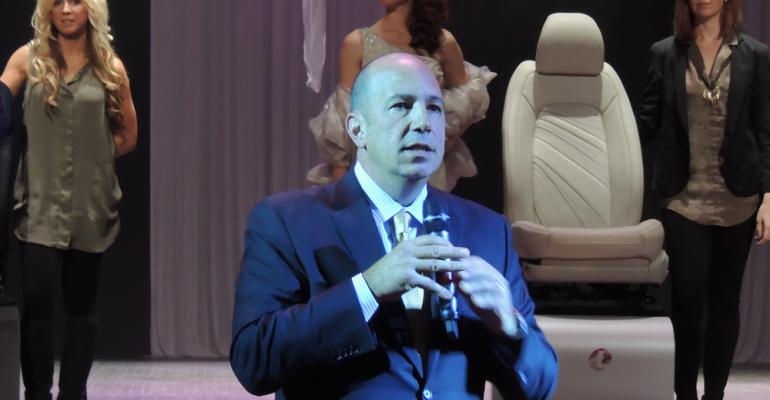DETROIT – Lear, among the many elite Tier 1 parts makers that drastically downsized and still ended up in bankruptcy court in 2009, is back from the economic abyss, talking about new technology and contemplating expansion.
The supplier, once capable of delivering complete interiors, restructured nearly a decade ago to concentrate exclusively on electrical-distribution systems and its original core business, seats.
This week, that focus is on full display as Lear hosts a fashion show highlighting next-generation automotive fabric and leather concepts for seating customers and media at the historic Fillmore Theater here.
From laser etching, printing, embossing and stain-resistant materials to seats that partially light up as an exotic design element, Lear’s display illustrates a desire to meet any automaker’s wildest dreams.
Many of the concepts, marketed as the TeXstyle family of fabrics, stem from the integration of Guilford Performance Textiles, which Lear acquired in 2012.
Vehicle producers are seeking ways to differentiate their products on global platforms, whether an entry-level subcompact or an Italian sports car, and clever, durable seating surfaces can make a positive first impression on a shopper, says Lear President and CEO Matt Simoncini.
“What’s great is we can do all of this – we can differentiate your product – and reduce the cost,” Simoncini tells journalists after five seating concepts are unveiled.
Central to the product push is the Aventino leather-finishing business Lear created organically in 2006 in response to a few automakers pushing for new competition in the segment.
The plant in Mexico has been running two shifts and has expanded incrementally over seven years. Employment at the plant has grown to 850, and another 200 workers will be added in 2014, the company says.
“It’s an area where we will continue to invest and we’ll be looking to expand our capability,” Simoncini says. “The demand (for leather) right now is huge.”
Lear has enough capacity to finish, cut and sew leather for now, but Jeneanne Hanley, vice president-global trim operations for seating, sees an urgent need.
“I believe in the next 24 months, we’ll need to expand our footprint in North America. We’re interested in other regions and studying it now,” she tells WardsAuto, adding that leather revenues will grow 40% next year based on booked business.
Lear’s Aventino unit has achieved a No.3 position in the North American automotive leather market, behind Eagle Ottawa and GST AutoLeather.
“When we see our success in growing from literally one or two customers to 20 programs now in a relatively short amount of time – it was 100% organic growth – we know we’re doing something right,” Hanley says. “We’re really studying the right point of entry in other markets.”
Globally, she estimates a 50/50 split between fabric and leather automotive seating surfaces. Of all the leather seats, Hanley says 70% incorporate some level of synthetic materials, such as Alcantara or vinyl.
Lear’s Aventino is all-natural, with no synthetic components. “We do not play in vinyl right now,” she says. “But we continue to study it.”
Lear is not in the tanning business, as is the case with Eagle Ottawa and others, but instead it finishes hides with pigments and various accents. About 70% of output at the Mexican plant is for Lear seats, and the rest is sold to other Tier 1 suppliers. “Our customers are directing our leather to our competition.”
Lear and Johnson Controls remain the world’s largest automotive seat producers, and Hanley admits JCI has an edge in Asia. “But they don’t have leather,” she says.
Economic indicators are positive as Lear today announces third-quarter earnings of $113 million ($1.45 per share, up 12%) based on $3.9 billion in sales. With robust vehicle production increases in China (8%) and North America (6%), Lear reports sales up 9% for seating and 17% for electrical systems, compared with like-2012.
The supplier expects full-year sales of $16 billion, up from $14.6 billion in 2012, and has returned about $1.7 billion to shareholders in the form of dividends and share repurchases since 2011.
Lear had 110,000 employees in 2004, downsized to 75,000 in 2009 and has rebuilt headcount to 113,000 today.



